The AMD Radeon R9 290X Review
by Ryan Smith on October 24, 2013 12:01 AM EST- Posted in
- GPUs
- AMD
- Radeon
- Hawaii
- Radeon 200
Company of Heroes 2
Our second benchmark in our benchmark suite is Relic Games’ Company of Heroes 2, the developer’s World War II Eastern Front themed RTS. For Company of Heroes 2 Relic was kind enough to put together a very strenuous built-in benchmark that was captured from one of the most demanding, snow-bound maps in the game, giving us a great look at CoH2’s performance at its worst. Consequently if a card can do well here then it should have no trouble throughout the rest of the game.
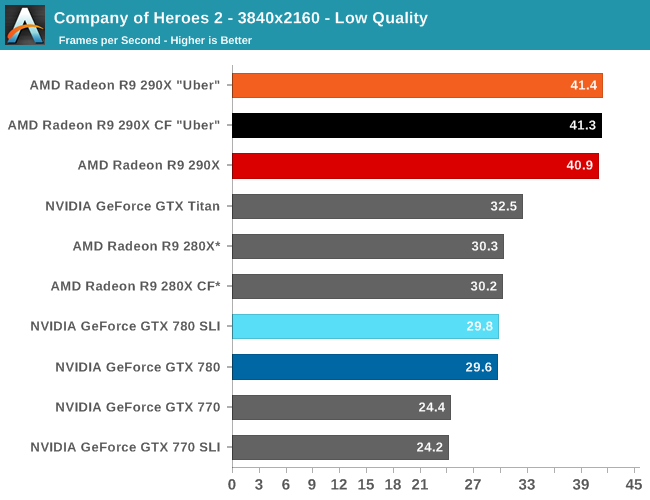
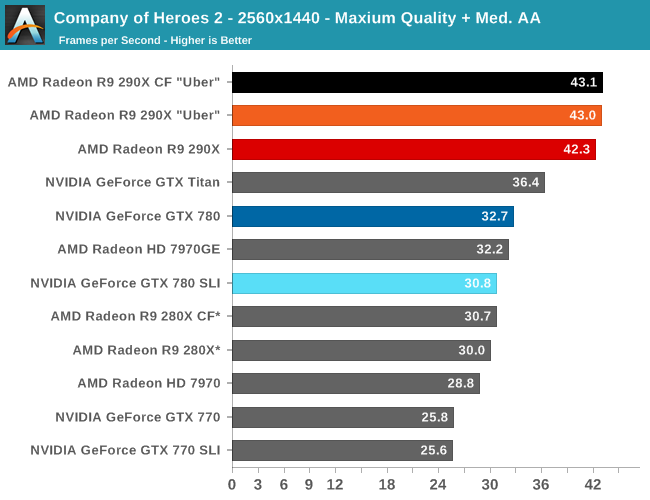
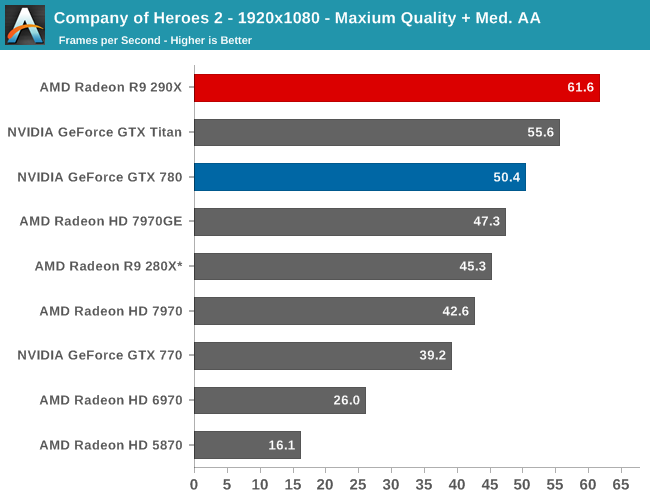
Our first strategy game is also our first game that is flat out AFR incompatible, and as a result the only way to get the best performance out of Company of Heroes 2 is with the fastest single-GPU card available. To that end this is a very clear victory for the 290X, and in fact will be the largest lead for the 290X of all of our benchmarks. At 2560 it’s a full 29% faster than the GTX 780, which all but puts the 290X in a class of its own. This game also shows some of the greatest gains for the 290X over the 280X, with the 290X surpassing its Tahti based predecessor by an equally chart topping 41%. It’s not clear what it is at this time that Company of Heroes 2 loves about 290X in particular, but as far as this game is concerned AMD has put together an architecture that maps well to the game’s needs.
Briefly, because of a lack of AFR compatibility 4K is only barely attainable with any kind of GPU setup. In fact we’re only throwing in the scale-less SLI/CF numbers to showcase that fact. We had to dial down our quality settings to Low on CoH2 in order to get a framerate above 30fps; even though we can be more liberal about playable framerates on strategy games, there still needs to be a cutoff for average framerates around that point. As a result 280X, GTX Titan, and 290X are the only cards to make that cutoff, with 290X being the clear winner. But the loss in quality to make 4K achievable is hardly worth the cost.
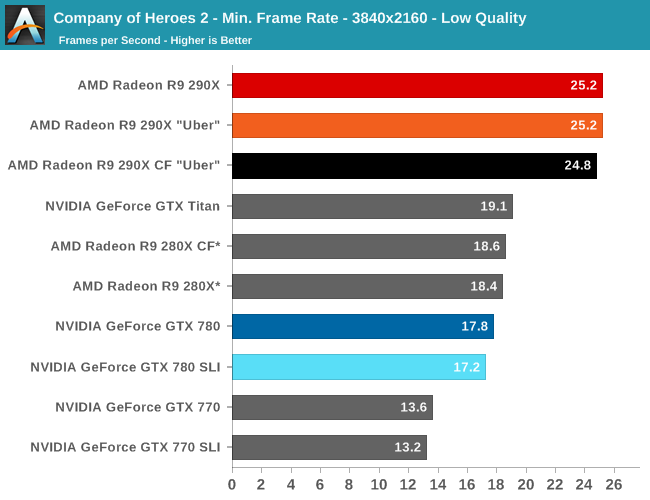
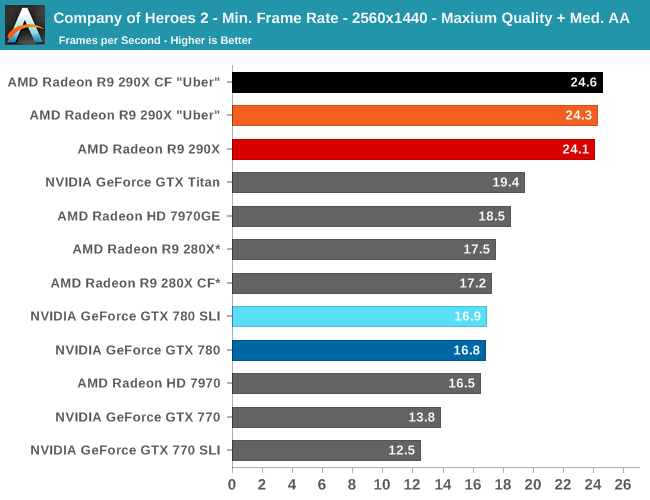

Moving on to minimum framerates, we see that at its most stressful points that nothing, not even 290X, can keep its minimums above 30fps. For a strategy game this is bearable, but we certainly wouldn’t mind more performance. AMD will be pleased though, as their performance advantage over the GTX 780 is only further extended here; a 29% average performance advantage becomes a 43% minimum performance advantage at 2560.
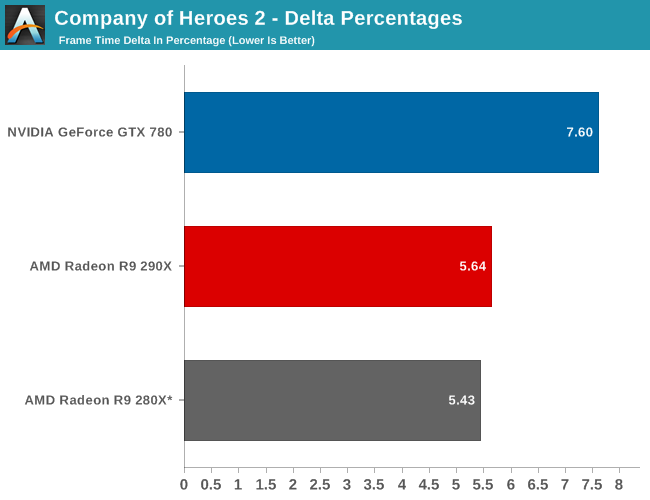
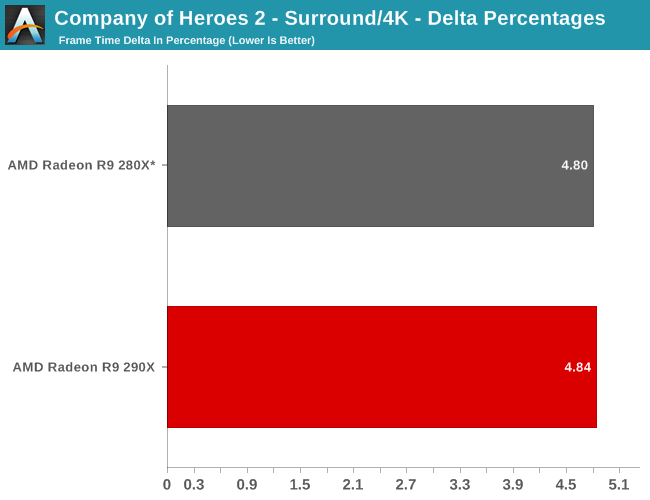
Finally, while we don’t see any performance advantages from AFR on this game we did run our FCAT benchmarks anyhow to quickly capture the delta percentages. Company of Heroes 2 has a higher than average variance even among single cards, which results in deltas being above 5%. The difference between 5% and 7% is not going to be too significant in practice here, but along with AMD’s performance advantage they do have slightly more consistent frame times than the GTX 780. Though in both the case of the 280X and the 290X we’re looking at what are essentially the same deltas, so while the 290X improves on framerates versus the 280X, it doesn’t bring with it any improvements in frame time consistency.










396 Comments
View All Comments
AtwaterFS - Thursday, October 24, 2013 - link
Nice, Nvidia has two choices, drop prices substantially, or drop trou.I certainly hope its the former, as I have no interest in seeing Jen-Hsun's pig in a blanket...
Wreckage - Thursday, October 24, 2013 - link
Not really the Titan slayer we were hoping for.After all this wait and hype it's not surpassing last years GK110. I guess we don't look for big gains in new chips anymore.
The Von Matrices - Thursday, October 24, 2013 - link
This is on the same process node as Titan. Big advances don't happen without process node shrinks, regardless of manufacturer.ninjaquick - Thursday, October 24, 2013 - link
A million times this... GCN is superior to Kepler, and probably Maxwell as well. It doesn't waste tons of die-space on large cache/special decoders/legacy bullshit. Game creators want massive arrays of simple math units that can voraciously crunch numbers, and that is what GCN delivers.EJS1980 - Thursday, October 24, 2013 - link
"GCN is superior to Kepler, and probably Maxwell as well"...HEHEH..... THIS IS PRETTY FUNNY, MAN......THANKS.....I NEEDED THAT! :PWill Robinson - Thursday, October 24, 2013 - link
Yeah right Wreckage...only slayed Titan by about $500 LOLIdiot.
chizow - Thursday, October 24, 2013 - link
Great price and performance from AMD without a doubt, it's not quite a clean sweep but it is certainly a convincing victory for R9 290X, especially at higher resolutions. 780Ti may come close or even exceed 290X, but the damage to Nvidia's product stack has been done.The symmetrical irony here is that this generation's price escalation that began at $550 with AMD's first 28nm part, Tahiti, has come full circle and brought back to balance with AMD's last 28nm part, Hawaii, again at that $550 price point.
I'm happy to see some balance back in the GPU market though, I stated this month's ago at 690 and Titan launch, that this $1K pricing model was an unsustainable business strategy for Nvidia. Now it's going to bite them squarely in the ass. They'll now reap what they sow and have to deal with the angst and anger from all of their most loyal fans who will undoubtedly feel as if they were cheated by the 690, Titan and even 780.
chizow - Thursday, October 24, 2013 - link
I guess it couldn't be all good news though, it looks like the leaked thermals, power consumption and acoustics weren't exaggerated. Definitely loud and hot, with high operating temps. I guess AMD really pushed the GPU to the max, I doubt there will be much more OC headroom, at least with the reference cooler.If Nvidia wasn't so greedy with 690/Titan/780 pricing 290X might've been the next Fermi with mixed reactions, but I'm sure the price and performance will overshadow heat/power concerns.
t41nt3d - Thursday, October 24, 2013 - link
NVIDIA won't be bitten in the ass at all due to the prices of the 690s and Titan. A god awful amount of people have paid $1000 (Including me) for one or more of these cards, and it's taken /8 Months/ for AMD to release a card that goes back and forth with the Titan - Doesn't outright beat it in some games, can go either way.NVIDIA have made a crapload of money from their two overpriced cards and have been reaping off this for a long time now, all they need to do is lower prices and no money lost. It's AMD who's been letting them get away with those prices for so long.
It seems a perfectly viable business strategy for them to have done what they've done and to be so successful at it.
chizow - Thursday, October 24, 2013 - link
I guess we will see, their job just got that much harder to try to sustain this $1000 pricing model now that a $550 card now matches and sometimes outperforms their $1000 card. What kind of performance do you think they're going to need next time to try and justify a $1000 pricetag?Again, Nvidia went down the path of an unsustainable business model predicated on the fact they would be an entire ASIC ahead of AMD. That lead was clearly short-lived due to Kepler's excellent overall performance, but Hawaii brought that dream back down to reality. Sure a bit late, but still in time to crash Nvidia's $1K parade.